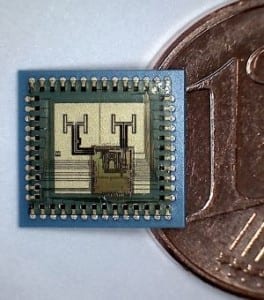
Today’s parking assistant systems enable drivers to safely park their cars even in the narrowest of gaps.
Thumbtack-sized Distance and Motion Sensor Developed by the SUCCESS Research Consortium / Radio-frequency Technology in a Chip Housing Facilitates Integration into Electronics Devices
Today’s parking assistant systems enable drivers to safely park their cars even in the narrowest of gaps. Such sophisticated parking aids, and also manufacturing robots which, to move about in unknown environments, require millimeter precision control, rely on precise all-around radar distance measurement. Together with the Karlsruhe Institute of Technology (KIT), the SUCCESS Consortium now has succeeded in integrating the necessary radar technology into millimeter-sized chip housings.
“For the first time now, we have succeeded in integrating all relevant radio-frequency components into one chip housing,” Thomas Zwick points out the advantage of this innovative technology. “Users can solder the chip onto their standard circuit boards and receive low-frequency signals that can be processed without difficulty,” Zwick, who heads KIT’s Institute for High-frequency Technology and Elec-tronics, goes on to explain.
The sensor sends and receives electromagnetic waves having a frequency of 122 GHz, which corresponds to a wavelength of ap-proximately two and a half millimeters. From the runtime of the waves, the distance to an object that is several meters away is cal-culated with an accuracy of up to less than one millimeter. In addition, the velocity of the respective object can be measured via the Doppler effect. The sensor itself, as a matter of fact, measures only 8 x 8 millimeters but contains all the necessary radio-frequency components. The output signals thus are signals of low frequency that can be processed further by means of standard electronic sys-tems.
Zwick is sure that “this compact technology will make accessible various new applications,” and that “in the long run, series production could reduce costs per radar sensor unit to less than one Euro.” Beside vehicle environment detection and control of industrial robots, there are numerous other conceivable applications, for example extremely flat door or gate motion sensors that can be hidden behind the wallpaper or drilling machines switching off automatically once the desired drilling depth is reached.
via Karlsruhe Institute of Technology
The Latest Streaming News: Radar sensor updated minute-by-minute
Bookmark this page and come back often
Latest NEWS
Latest VIDEO








